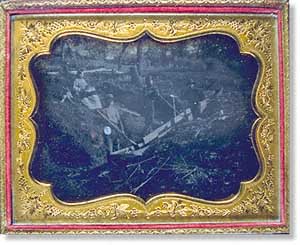 

|
 |
Fred Stocking, His
Bride Lucinda Stocking, and His Partners, Big Oak
Flat, Tuolumne County, 1856


Unknown Maker, Fred
Stocking, His Bride Lucinda Stocking, and His
Partners, Big Oak Flat, Tuolumne County, 1856,
Half plate daguerreotype. Collection of the
Oakland Museum of California, gift of Concourse
d'Antiques |
|
| |
|
Fred
Stocking arrived in California in 1853, after escaping
the sinking ship Tennessee. After digging and mining for
a while, he was successful enough to write to his beloved
Lucinda in New Haven, Connecticut, and have her secure
passage via Panama to California. She arrived without
incident on December 15, 1855. She and Fred, along with
his twin brother and his partner (the other two men
pictured in this photograph), continued to search for
gold in Tuolumne County and to build a more sizeable
cabin for the Stocking clan. This daguerreotype (which is
slightly underexposed and therefore darker) is
significant as one of only two known daguerreotypes in
existence that shows a woman in the gold fields. The
woman is reading a book and sitting with her dog, not
working at the diggings or helping with the extraction of
gold. She is dressed simply, with her hair fashionably
parted in the middle and kept close to her head. She
wears crossed silk ribbons around her neck, fastened with
a modest broach. The men are dressed in standard gold
field apparel.
This
photograph also shows the effects of man's incursion on
nature. The tree-stumps and felled trees in the
background attest to the influence of the waves of gold
seekers on the natural habitat of California.
|
 |